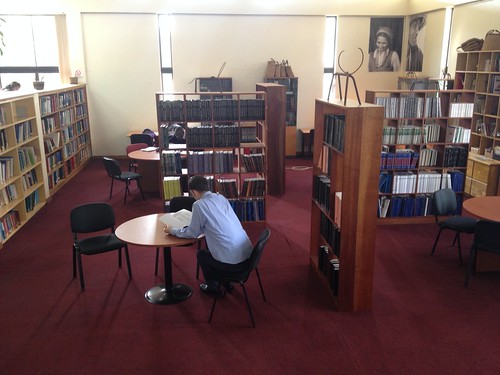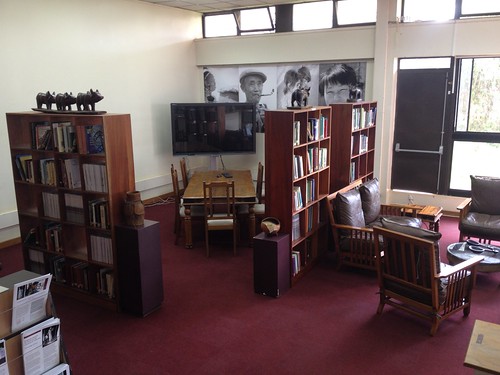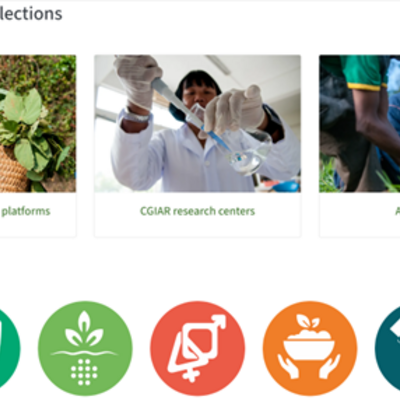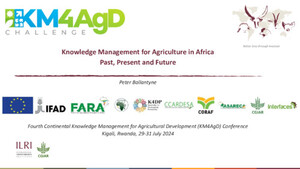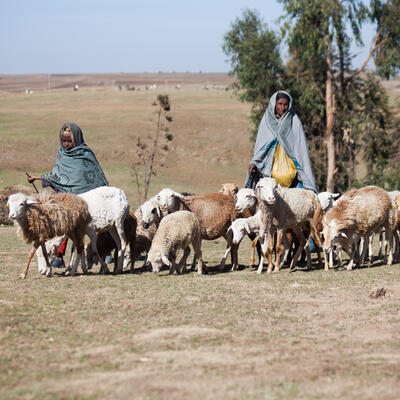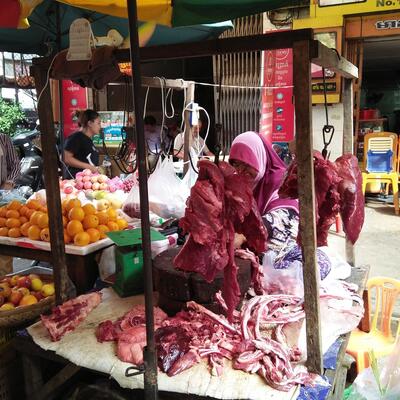
Towards innovation-spaces: Slowly evolving the ILRI Nairobi info-centre

@BecAHub Mark Wamalwa explains how illumina sequencer is used on the genomics platform [from twitter]
Just as scientists at the International Livestock Research Institute (ILRI) innovate and evolve next generation vaccines and genomic opportunities, we see significant evolution in the roles of infocentres and libraries in agricultural research. The infocentre spaces and services in ILRI are no exception.
While physical collections of books and journals were critical to research in the 1980’s and 1990’s, today’s agricultural scientists mainly rely on access to digital data, knowledge and science. More and more, librarians in research organizations are moving from roles as guardians of physical materials to curators of digital knowledge and facilitators of knowledge exchange. They no longer maintain indexes and catalogues, today they manage institutional repositories, publish services across the web and facilitate meetings.
ILRI’s infocentres in Addis Ababa and Nairobi have come a long way from their origins as reference libraries for scholars and visiting students. Over the last ten years their central purpose has gradually evolved from offering library services to a broader portfolio focused on knowledge exchange. Part of it has been an internet cafe from before the days when broadband access was widely available. The collection has moved online, researchers access critical resources like journals directly from their computers. The users of our Nairobi infocentre hardly read the books we provide, they seem to mostly look for a quiet space to work or to meet with colleagues and supervisors. Looking north, ILRI’s Addis Ababa infocentre is a hub of meetings and interaction where individuals and projects engage, plan and interact.
The evolving Nairobi infocentre
In Nairobi, we are pursuing ways to reinforce the institute’s culture of innovation. We are currently transforming the infocentre on the Nairobi campus into a multi-use co-working space. Our goal is to create a flexible collaboration hub for researchers, PhD students, fellows, staff from the regions and partners alike. It will bring together a community of users involved in agricultural research from diverse disciplines and backgrounds in an open collaboration space. It will help to bridge the spaces between people working up and down the ILRI hillside, and among those mainly in labs, office or the field.
One of our assumptions is that people who meet in such spaces will strike up conversations and these conversations will lead to new ideas and ultimately innovation. We want to help enable and ignite these casual meetings and serendipitous conversations. We also want to keep offering quieter spaces for study and individual or small group work. And we continue to provide space for traditional books and journals, especially those that are more difficult to access. We especially want to make some of our ‘archive’ special materials of ILRI archive reports, theses and other materials more accessible (they have been closed away for many years).
Space plans
The current ideas for the infocentre space have evolved in the past year or so. Looking for the potential multiple uses, the current very simple design concept reflects the values of the community we want to serve: Openness, transparency, collaboration and ultimately innovation. The space is open, brightly lit with natural light and functionally furnished and features dozens of livestock-related artefacts illustrating the multiple uses of livestock and animal products in culture and lives.
We envision three zones:
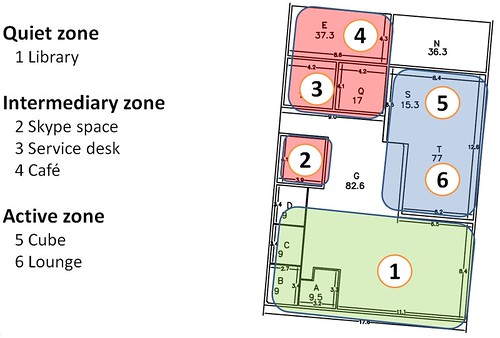 Quiet zone: For people looking for a private work setting. This is the part of the infocentre that will simply remain ‘library’ space, with its existing code of behaviour that is respectful towards other users’ need to focus on individual work. Cell phone use and videoconferencing is discouraged, the boundaries signal “do not disturb.” Activities supported by the space are studying, writing and thinking. The books and other materials are food for thought and exploration.
Quiet zone: For people looking for a private work setting. This is the part of the infocentre that will simply remain ‘library’ space, with its existing code of behaviour that is respectful towards other users’ need to focus on individual work. Cell phone use and videoconferencing is discouraged, the boundaries signal “do not disturb.” Activities supported by the space are studying, writing and thinking. The books and other materials are food for thought and exploration.
Intermediate zone: The potential ‘cafe-like zone’ encourages meetings, conversation and cross pollination. Some may choose to work here accepting disturbance (as at airports or internet hangouts). This is also the space where staff work and can mingle with visitors. It is situated so people will pass through as they enter co-working spaces. We aim to convert a closed store room into a small space where staff can join virtual meetings such as skype without disturbing the quieter area.
Active zone: This area is set up to support small groups discussing or collaborating. With its smartboard, it is perfect for small group work, team meetings, presentations, video conferencing, etc. Ideally this will be a ‘Cube’ with glass walls making the interactions visible but not audible. Next to the cube, we will re-introduce a ‘Lounge’ area as an informal space without tables and barriers. Again, this will ideally be divided from the quiet zone by glass walls, thereby maintaining an uninterrupted, visually open space while keeping the noise in.
This is all work in progress, reporting and sharing some of the changes we are doing and contemplating. As we increasingly move our knowledge resources online and open access, reducing barriers to innovation, we are exploring ways our traditional physical spaces can be made more accessible, open and pro-innovation while retaining elements of the past that still add value.
This post was written by Ben Hack and Peter Ballantyne





